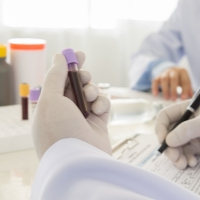A tumour marker is a substance of the blood that appears at a higher level than expected in your blood, in your urine or in a sample of your tissue. They may be produced by the presence of cancerous cells or by perfectly healthy cells.

Blood tests may be done:
- to help in the diagnosis of cancer
- to find out if cancer treatment is working
- to find out if cancer has come back (recurred) after treatment
The lab report containing your test results should include the relevant reference range for your test(s). Please check with your doctor or the laboratory that performed the test(s) to obtain the reference range if you don’t have your lab report.
CEA
Slight CEA elevations (rarely above 10) can occur in some of benign diseases of the intestine, the pancreas, the liver and the lungs (including liver cirrhosis, chronic hepatitis, pancreatitis, ulcerative colitis, Crohn’s disease, and emphysema). Smokers geneally also have elevated CEA.
A CEA level within the given reference range doesn’t guarantee that cancer (even the kinds known to produce CEA) isn’t present, the test isn’t specific enough for that and therefore the CEA test isn’t useful on its own for diagnostic purposes.
CA 125
CA125 is usually used as test for ovarian cancer so sometimes men aren’t offered this blood test. Slight elevations can also occur in people with cirrhosis, hepatitis, endometriosis, ovarian cysts, and pelvic inflammatory disease as well as in the first trimester pregnancy.
Non-ovarian malignancies include cervical, liver, pancreatic, lung, colon, stomach, biliary tract, uterine, fallopian tube, breast and endometrial carcinomas. As you can see, it isn’t a very specific test.
CA 19-9
Elevated CA 19-9 serum levels can occur as a result of cholestasis, which is described by NICE as an impairment of bile formation and/or bile flow. Elevated values can also found with inflammatory diseases of the gastrointestinal tract or the liver as well as in cystic fibrosis patients. Again, not a specific test.

Written by: Pseudomyxoma Survivor editorial team
Updated: August 9, 2019
References
Expression of CEA, CA19-9, CA125, and EpCAM in pseudomyxoma peritonei
Prognostic Value of CEA, CA19-9, CA125, CA724, and CA242 in Serum and Ascites
Cytoreductive Surgery and Perioperative Intraperitoneal Chemotherapy as a Curative Approach to Pseudomyxoma Peritonei Syndrome
Sugarbaker PH. Cytoreductive Surgery and Perioperative Intraperitoneal Chemotherapy as a Curative Approach to Pseudomyxoma Peritonei Syndrome. Tumori Journal. 2001;87(4):3-5. Retrived August 9, 2019, from doi:10.1177/030089160108700415
Significance of serum tumor marker levels in peritoneal carcinomatosis of appendiceal origin
Home > Information about PMP > Frequently asked questions > Tumour markers CEA, CA125 and CA19-9, what are they and what do they mean?

My tumour markers went from 4.3 to 7.6 in 10 months
Whilst receiving chemo
Hi, quick question. I had a low grade appendix tumour removed after an incidental find. It does not appear to have leaked. I was never given a blood test before or since. This was 10 months ago, are blood checks important in this instance. The opp was elective and with the identity of the tumour understood.
Hi Lorne – some tumour markers can be found in blood and so they can give an indication for some people. They are only useful when a baseline reading has been taken, when you had your operation they may have taken a sample of blood to establish the baseline? Are you still under the care of the hospital and receiving regular checks i.e. scans etc?
My husband was diagnosed with pmp in 2017, recently his blood test for tumor makers was at 887, how worse is that?
Hi Margaret – I wonder what tumour marker that was? They are not an exact science, so it will depend on the baseline tests as to whether they are alarmingly elevated. Is the doctor concerned?
Can ca 19-9 be used to help to detect colon cancer
Hi Orla – yes it can be used.
By chance after undergoing removal of gallbladder my husband was told his appendix was enlarged it turned out to be a muconous cancer of the appendix, he had the appendix removed and later was told lesions where seen on the appendix however that was 2 years ago and no recurrent disease has been found his next scan is due in Sept.
He is eager to get this next scan as he recently has been having pain in his right pelvic area plus some bloating of his abdomen, could be unrelated but it’s always a worry that the cancer has now manifested.
My CA19.9 reading was quiet low. How I am confirmed to have Colon Cancer now?
Christine Collins,
I had a dull pain in my right hand lower abdomen on 2-jan-2022.
After a CT scan and key hole surgery as an investigation I was diagnosed odes with PMP, it turns out I have/ had Low grade Mucinous Neoplasm and a Neuroendicrine Tumour. After CRS/HIPEC treatment on 21-Feb-2022 I have had multiple organs removed plus the Greater and lesser Ommentum.
The swelling of the Ommentum due to mucous was causing my abdomen to swell over the years, it appears I may have had the condition between 5-10 years. Get your husband back to the doctors for a full scan from pelvis to neck as a precaution to check for PMP.
Get the scan and blood test for markers. By the time they found My Sister‘s cancer, it had gone from her pancreas up behind her liver and wrapped around her portal vein. They said it was probably active for over 10 years before they found it. We are in a radiation treatment that has shown great improvement but she will never be without cancer. We are just trying to keep it from growing. The pet scan they do on her to determine the growth is called. AC-225 Dotatate. It is supposed to be one of the best to look for cancer throughout the abdominal cavity. The copper base is the one they use on her. Apparently that matters too.
I was diagnosed with PMP in February 2012. After several years I had to have the HIPEC in September 2018. It has started to come back and I’m trying to find out if there are any trails.
CA 125 is 3562 increasing during chemo
My daughter’s CA 125 is 65. Can someone tell me what that means. I cannot get in touch with the doctor.
Hi Cathy, hopefully the doctor has been able to answer this for you? We are not medical experts, nor do we have access to her medical files where they can determine trends in her results (these trends are the indicators for the specialist teams).